NOTE: This is part of an onging series of articles concerning my Europe trip. See below for links to the previous articles:
Overview
****************
1st Course: An assortment of fresh seafood
Barcelona
Barcelona is a gourmet’s Disneyland. When I stepped out of my hostel to begin my first day exploring the city, I was overwhelmed, both with the scope of culinary specialties in Barcelona and the scale of the city. It is the kind of city where one can spend years and never fully know; it has a predilection to dark, windy side streets and alleys that are invariably stocked with bars, restaurants, bakeries and small markets that beckon seductively.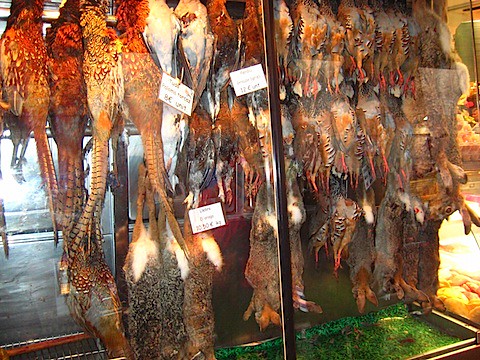
Above: A storefront of a butcher. There is a definite connection in Barcelona between the death of an animal, and your dinner.
Food is given serious attention in Barcelona. Women stroll along the alleys, deep in serious thought to the merits of the baguettes at a particular bakery, to the deficiencies of the tapas displayed in the window of a bar. I spent many hours during my stay wandering those back alleys, going wherever the window displays looked good.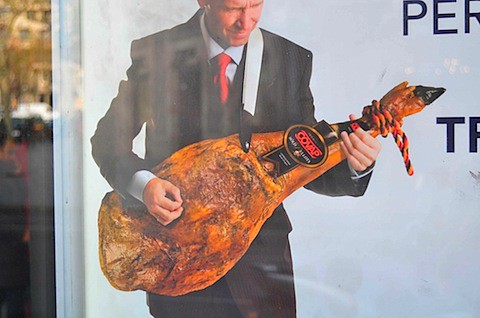
Above: A man playing a leg of jamon serrano as a guitar. In an advertisement.
Besides my aimless, bohemian wandering, I really did have definite goals in Spain. I wanted to have paella by the seashore, and I wanted to enjoy a hearty meal of raciones, the hearty bar food of Catalunya, preferably with some of their young, sparkling white wine called cava. Neither was difficult to complete, I am happy to say.
I scratched my itch of paella at a delightful seafront restaurant along the Barceloneta; the shorefront that was renovated for the 1992 Olympics. Along the shore there are dozens of paella restaurants, all with excellent patio seating under heatlamps, because it was just slightly too cold to do without. So after a morning of exploring the seafront, it was a pleasure to sit down along the Spanish seashore and order two paella, some sangria and a few tapas as appetizers. To sate my ravenous appetites, as well as the hunger of my traveling companions, we ordered small, whole squid that had been sautéed very simply in some olive oil and garlic, as well as some croquetas de jambon: potato croquets with that succulent Spanish ham.
To say that this food was bursting with flavor would be to gloss over the delicious nuances of each of these dishes, even though they were but mere appetizers. The very small, baby squid were chewy intiailly, but quickly yielded to ones morsels, allowing you to savor the delicious combination of garlic, oil and squid- a combination that is undeniably nautical, and will, I am sure, forever take me back to that restaurant. The croquets were not as nuanced, but rather more juvenilly delicious. Who can resist the siren appeal of cheese, delicious, mouth-wateringly tender and flavorful ham, and fried potato? While not as “exotic”, they were equally delicious, and went great with some fruity Sangria.
To follow, we ordered two paellas. The first was a paella mixta: a typical seafood paella of whole shrimp, prawns, clams and mussels in a golden bed of saffron rice. The second was a paella de arroz negra: a paella with rice colored black with squid ink. It tasted strongly of ham and calamari and mussels, and was far better than the simpler seafood paella. It had all the elements that make a great meal for me: good food, great company and great location.
For dinner, we cleaned up and headed into the charming area of town know as the barri gotic; a winding sprawl of small one lane roads that contains that vast majority of the cities small, charming restaurants. We happily wandered into an inviting cava bar, which we later found was recommended by the Lonely Planet guidebook that was my bible.
We wandered in starving, as we would to most meals in Barcelona, because dinner is usually eaten at 2, and dinner can be as late as 11. The Casa Delfinn’s wood paneled ceiling was great, but what we really craved were some hearty raciones. Fortunately, the cava hit the table quickly, as did our food. We started off the omnipresent pan con tomates: a simple baguette, toasted, and then rubbed with garlic, olive oil and the flesh of a tomato. It kept the cava company as we waited for the real meal to begin. The following courses did not disappoint. The first racion was a dish of inch thick octopus tentacles: perfectly cooked, tender and flavorful, although aggressive looking. It was followed by an Iberian sampler, which included manchego cheese, jamon Serrano, copa and a morcilla sausage. We concluded with a seafood sampler of salted cod (bacalao), cuttlefish, prawns and shrimp. The meal was a wonderful sampler of Barcelona’s many specialties, and whet our appetite for slightly more sophisticated fare.

Above: A selection of montadillas; snacks on toast, in other words. From left to right, you are seeing salted cod, anchovie, and jamon serrano.

Above: One of the most crazy looking dishes. This was octopus a la catalan. On the right are some golden potatoes. The octopus, by the way, was perfect, and nearly and inch thick.
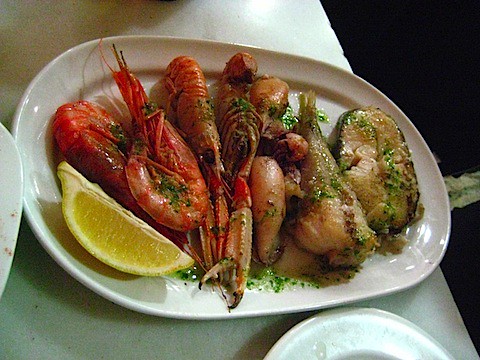
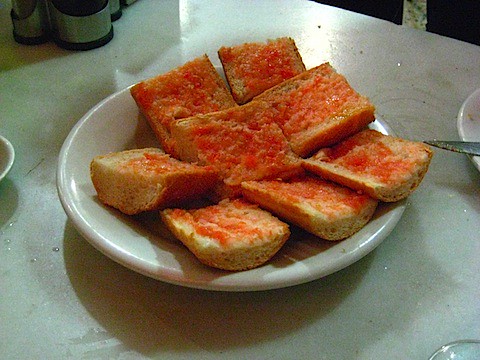
Above: That quintessential bar food: pan con tomates.
You see, while my companions and I do not mind sharing per se, we enjoy having “our own” food. Café Gloria, in the same old neighborhood as Casa Delfinn, provided exactly that on our second night, with a prix fixe menu that was the foundation of one of my favorite meals on the trip.
I should mention at this point that in Spain and France, the prix fixe menus almost always include wine; a very civilized practice. The Café Gloria, it should be noted, was no exception. Their straightforward housewine, served in an unadorned bottle, was the perfect lubricant and companion for my three course meal.
It started out with homemade cannelloni (yes- Italian!) in a cheese gratin. Following it up was some classic café food: a entrecote ternera (steak), which was gorgeously seared on the outside and juicily rare within. For desert, I had the quintessential flan. It is not my favorite, but I felt I had to get it once. My companion Tyrone picked the best main course, however: cornero al horno en su jugo (shank of lamb braised in its own juices). I should note this was to be a trend- Tyrone always seemed to pick the best looking entrees. Anyway, the lamb was flavorful and tender, and while my steak was no slouch, his entrée was far superior. We got up from dinner to discover that it was somehow 1:30 in the morning: we had been at the table for two and a half hours. I am happy to report we maintained that pleasurable dining speed for almost all of our dinners.
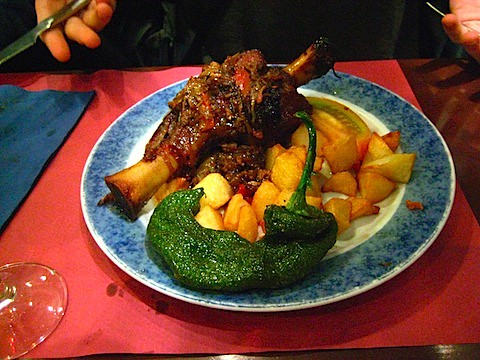
Above: My friend Tyrone's lamb. Excuse the camera work. I was tipsy.
I’m not going to lie about that meal: that wine definitely hit my bloodstream before the food, which really led to a splendid hour long debate concerning communism versus capitalism- a argument that was ongoing throughout the trip. However, it was a academic argument, and led to a pleasant night with no hard feelings.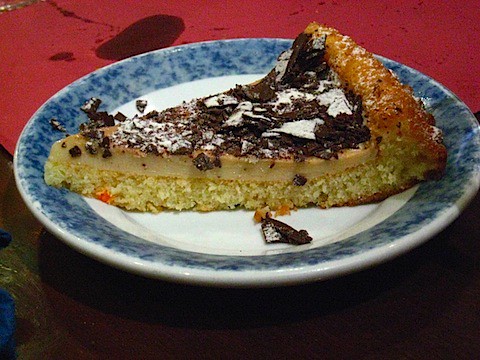
Barcelona’s dining hours cannot be bettered. My day started bright and early. I would hit a cerverceria (a bar) or a cafeteria for some coffee and a pastry.
In general, I was not the most impressed by Spain’s pastries- I think that the Germans cannot be bear in the noble art of making a hearty breakfast treat, and the French are far superior in the flaky, more delicate style of pastry-smithing. The arena in which Spain excels is the savory pastry, that golden-brown pinnacle of fast snack, the empanada. An empanada, when done correctly, is a flaky, delicious crust that is folded over a savory, meaty interior. In the US, I have seen that filling be either ham, beef, chicken, seafood or vegetables. In Barcelona, the only filling I ever saw was tuna with tomatoes and olives. Make no mistake-this wasn’t just some grocery store “Chicken of the Sea”, water packed tuna- this was tuna with some real flavor! Juicy and tender! An with every bite, delicious little morsels of olive explode in your mouth. My first empanada was such a flavor revelation that I literally could not identify the filling when I first bit into it. I had to become a culinary private eye.
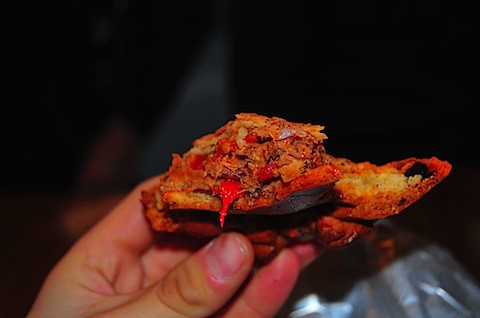
Above: Emapanada de aton- that delicious tuna emapanada.
Back to meal times: Barcelonians are night people. At 8, we would just be catching the bars and coffee shops opening up. We would sight see until about 10 to 11, when I would usually swing by someplace for a bocadillo and some wine. Bocadillos are the ubiquitous Spanish sandwiches, made on a relatively thin baguette. The fillings can be over any variety, although the most common varieties are tortilla (an egg preparation very similar to a frittata- served room temperature), jamon Serrano or sabrosada- a type of delicious sausage. However, the filling can be anything.
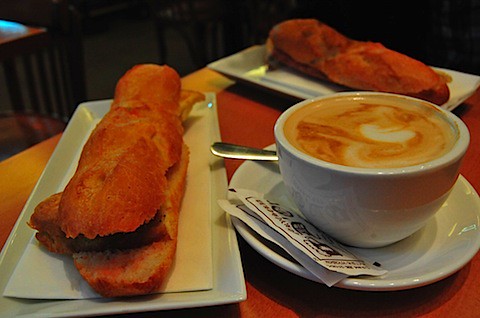
The bocadillia would give me the inner strength to continue onto a late lunch- around 3 in Barcelona, and a bit earlier in the rest of Spain. Lunches could be anything- from paella, to foccacia pizzas and apple crumble (pictured below). It really depended on our mood.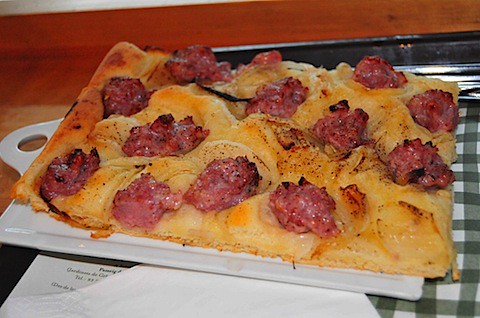
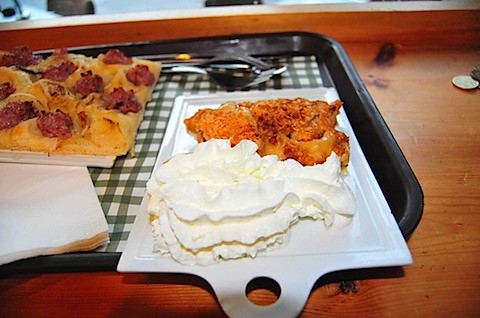
Around 7 or 8, I would generally get a trifle puckish- snack time! This could be anything. Oftentimes, it would be whatever I picked up in a market- from tapas, to chocolate, to more bocadillas.
Finally, around 12 to 1 we would have dinner, as I have described. The great thing about these hours is that they let me eat the food of three days in one- very handy! Keep in mind that I was also snacking on any sort of unique candy bar, pastry or other culinary delight that was for sale. Damn those Spaniards and their gorgeous window displays! See below: the beautifully sculpted marzipan creations that some of the more gourmet candy shops specialize in.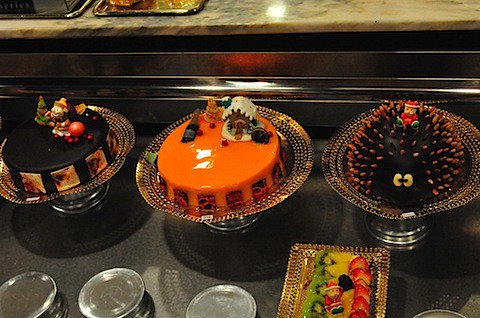
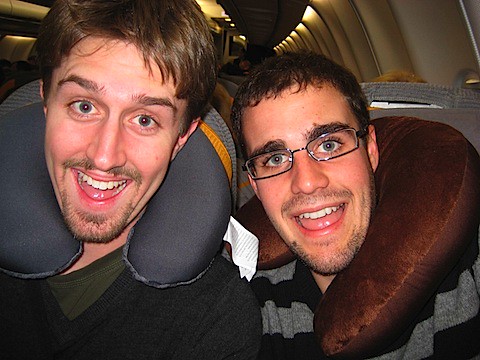
No comments:
Post a Comment